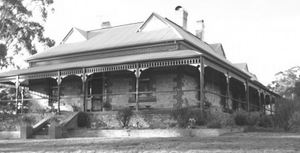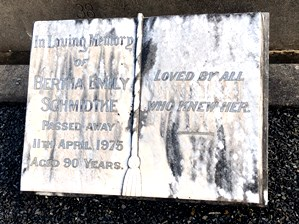Life and Achievements of Nurse Bertha Emilie Schmidtke
Extract from Hahndorf Village Voice Edition 66 Winter 2021
 Bertha Emily Schmidtke has been described as a trailblazer for her time, always progressive in her ideas, forthright in her personality and resilient in her nature. Whilst having a deep and quiet level of compassion, integrity, and humanity at her core. This remarkable woman, whom against all odds established and ran the Hahndorf Maternity Hospital, in what is now the Hahndorf Academy for 16 years. Showcasing and recognising the valuable achievements Bertha made during her life and career is critical in building upon and celebrating our town’s long and interesting history.
Bertha Emily Schmidtke has been described as a trailblazer for her time, always progressive in her ideas, forthright in her personality and resilient in her nature. Whilst having a deep and quiet level of compassion, integrity, and humanity at her core. This remarkable woman, whom against all odds established and ran the Hahndorf Maternity Hospital, in what is now the Hahndorf Academy for 16 years. Showcasing and recognising the valuable achievements Bertha made during her life and career is critical in building upon and celebrating our town’s long and interesting history.
Bertha was born in Hahndorf on the 22 March 1885. She was the daughter to August Henrich Schmidtke and Wilhelmine Schmidtke (nee Ritter), Prussian immigrants aboard the ship Elisabeth from Humburg in 1878. Bertha was sister to Johanne Auguste, Bertha Hulda, Carl Edward, Otto Gottlieb, Louise Emma, Wilhelm August, Augusta Bertha (exact names, number and order of siblings is not entirely known).
In the early 1900’s Bertha Schmidtke resided at the homestead ‘Shady Grove’, the residence of her sister Bertha Hulda Hirte (nee Schmidtke) and brother-in-law Heinrich Alfred Hirte.
 Main Street and Hahndorf College 1912From the years of 1910 to 1918, Bertha was mentored by Dr Theo Auricht (Hahndorf district resident medical doctor) as his Midwifery protégé. This was invaluable experience for Bertha as most births occurred in the family home.
Main Street and Hahndorf College 1912From the years of 1910 to 1918, Bertha was mentored by Dr Theo Auricht (Hahndorf district resident medical doctor) as his Midwifery protégé. This was invaluable experience for Bertha as most births occurred in the family home.
In 1918, Nurse Bertha Schmidtke gains a Maternity license from the local Echunga District Council to operate a small Maternity Hospital. On 28 January 1919, the former Hahndorf College located at 68 Main Street, now the Hahndorf Academy, was purchased by Nurse Bertha’s brother in law, Heinrich Hirte. The premises were offered on loan to Nurse Bertha to pursue her vision of a Private Maternity Hospital for the district. During this time, Nurse Bertha moved into Douglas Byard’s former residence attached to the hospital and continued to live there for 39 years. Under Nurse Bertha’s direction and care, the Hahndorf Maternity hospital grew in its reputation with many expectant mothers coming from districts far and wide to give birth at the Maternity hospital.
 Hahndorf Academy c1950 (with balconies still intact)On 27 July 1925, The Hahndorf Maternity Hospital extends its licence and becomes a Private General Hospital. During this time with the support of Dr Theo Auricht, the hospital expands to include a men’s ward, an infectious disease sanatorium, an operating theatre, later a dental surgery, a lying-in ward and a place to temporarily store the towns deceased in preparation for burial. At this time the former bathroom used for the College was converted into an operating theatre and prior to a procedure, Nurse Schmidtke sterilised surgical instruments in a huge cauldron on the kitchen stove.
Hahndorf Academy c1950 (with balconies still intact)On 27 July 1925, The Hahndorf Maternity Hospital extends its licence and becomes a Private General Hospital. During this time with the support of Dr Theo Auricht, the hospital expands to include a men’s ward, an infectious disease sanatorium, an operating theatre, later a dental surgery, a lying-in ward and a place to temporarily store the towns deceased in preparation for burial. At this time the former bathroom used for the College was converted into an operating theatre and prior to a procedure, Nurse Schmidtke sterilised surgical instruments in a huge cauldron on the kitchen stove.
Nurse Schmidtke largely ran the hospital herself with one support nurse on duty. This person was often one of her sisters or nieces. Surgeries were performed by Dr Auricht and visiting Surgeons. During these years, 999 patients were cared for and 580 babies were birthed and officially recorded (actual birth numbers are likely to be higher). In 1935, Nurse Bertha Schmidtke retires from institutional nursing aged 50 years. Patients and equipment are transferred to the Ambleside Private Hospital located at 110 Main Street and continues servicing patients for another 5 years under the management of Dr Auricht.
 Ambleside Private Hospital - 110 Main StreetNurse Bertha’s brother-in-law, Henrich Hirte dies in 1939 and Bertha inherits the property located at 68 Main Street. Bertha makes history by continuing to run the Betting shop (1934), she is claimed to be one of few females in South Australia to do so.
Ambleside Private Hospital - 110 Main StreetNurse Bertha’s brother-in-law, Henrich Hirte dies in 1939 and Bertha inherits the property located at 68 Main Street. Bertha makes history by continuing to run the Betting shop (1934), she is claimed to be one of few females in South Australia to do so.
As the Second World War begins in 1939 the continuing effects of the economic depression in Australia has an impact on the availability of housing. Nurse Bertha starts to let out portions of the former Hahndorf hospital (Hahndorf Academy) to struggling families, in particular newly married women with children whose husbands were away at war. Nurse Bertha continues to take on extended periods of nursing in the district. She could often be seen driving around the district in her black Humber.
 Bertha Schmidtke headstone Hahndorf cemeteryIn the 1940 to late 1950’s post war with immigration on the rise many displaced families found themselves occupying all corners of the former Hahndorf hospital, now referred to as the Hahndorf College flats. Comforts were rare as conditions were crowded with make shift walls; amenities were shared. Life was largely communal living. Despite this, a thriving community life existed in these times with many stories of card nights and children playing in the hidden treasures of the old building and the garden and creek that surrounded the property.
Bertha Schmidtke headstone Hahndorf cemeteryIn the 1940 to late 1950’s post war with immigration on the rise many displaced families found themselves occupying all corners of the former Hahndorf hospital, now referred to as the Hahndorf College flats. Comforts were rare as conditions were crowded with make shift walls; amenities were shared. Life was largely communal living. Despite this, a thriving community life existed in these times with many stories of card nights and children playing in the hidden treasures of the old building and the garden and creek that surrounded the property.
In 1958 aged 73, Nurse Bertha either alone or in agreement with her niece, Dulcie Paech nee Hirte (daughter of Nurse Bertha’s sister Bertha Hulda Hirte and Heinrich Hirte) decided that the guardianship of 68 Main Street (Hahndorf Academy) had come to an end. The building was sold to an old Scholar Otto Haebich. Nurse Bertha retired to a small cottage on Church Street, opposite St Michael’s church where she remained until she passed away aged 90. Nurse Bertha was laid to rest in 1975 at the Hahndorf Cemetery. Bertha Emilie Schmidtke was the heart and soul of the Hahndorf Hospital and Hahndorf College flats for 39 years.
Sources:
-
‘A College in the Wattles’ by local Hahndorf Historian Reginald (Reg) Graham Butler,
-
Deborah Twining - ‘When tales are long and often turn corners’,
-
2019 exhibition at Hahndorf Academy (courtesy of the artist),
-
Localwiki and Hahndorf Allotment Database,
-
www.myheritage.com are acknowledged for the historical references.
Article compiled by:
Nadia Fountas, Co-Editor, Hahndorf Village Voice


